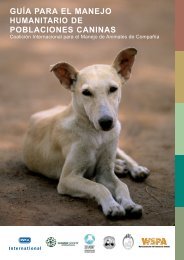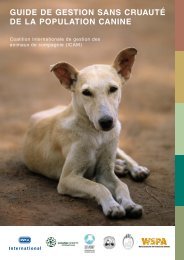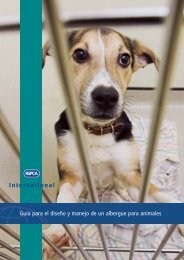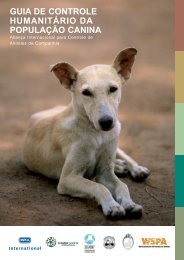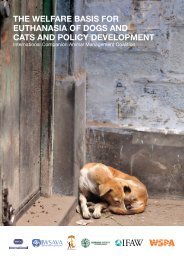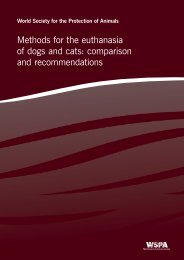HUMANE DOG POPULATION MANAGEMENT GUIDANCE - ICAM ...
HUMANE DOG POPULATION MANAGEMENT GUIDANCE - ICAM ...
HUMANE DOG POPULATION MANAGEMENT GUIDANCE - ICAM ...
Create successful ePaper yourself
Turn your PDF publications into a flip-book with our unique Google optimized e-Paper software.
B. Influential factors in dog population management: Consider a range of<br />
factors that influence dog population welfare and size and decide which to prioritise<br />
Completion of the initial assessment will provide both data on and insights into the local situation. The next stage is to<br />
highlight which factors are the most important and so should be prioritised in the management programme; identifying<br />
these priority factors will ensure that resources are not spent on issues that have only a minor impact on the wider<br />
problem. In almost all situations more than one factor will be important, so an effective strategy will require a combination<br />
of interventions.<br />
The following is a list of factors that are frequently listed as<br />
priorities in dog population management. These are split into<br />
those that influence population size and those that influence or<br />
motivate people to attempt to control the population. However,<br />
others may be relevant in certain conditions and it is important<br />
to stay focused on what is appropriate for the target community<br />
and the causes of roaming dog populations, not just the effects.<br />
Factors influencing dog population size<br />
Human attitudes and behaviour<br />
Aim: To encourage responsible ownership.<br />
Human behaviour is likely to be the most powerful force behind<br />
dog population dynamics. The encouraging of responsible and<br />
rewarding human-animal interactions will lead to both an<br />
improvement in animal welfare and a reduction in many of the<br />
sources of roaming dogs. The owned dog population may be<br />
found to be a significant source of roaming dogs and may suffer<br />
from many preventable welfare problems, and human behaviour<br />
towards dogs will be the driving force behind these problems.<br />
Several issues need to be considered when exploring human<br />
attitudes and behaviour.<br />
a. Local beliefs and attitudes may affect human behaviour<br />
towards dogs. It may be possible to address these beliefs to<br />
change behavioural outcomes. For example, a belief that<br />
sterilisation will cause negative behavioural changes in dogs<br />
can be addressed through education and examples of<br />
sterilised dogs in the community, so encouraging owners to<br />
seek sterilisation for their dogs.<br />
d. Interventions to change human behaviour should be tailored<br />
carefully to your target audience as different methodologies<br />
will be required for different ages and cultures. It is<br />
important to understand the most effective ways of<br />
communicating to each target audience.<br />
e. Because human behaviour is such a key factor of success, it<br />
is important that owners are not only aware of interventions<br />
but fully understand and engage in all relevant aspects (see<br />
Case study 1).<br />
CASE STUDY 1<br />
An example of human attitudes that could<br />
affect dog population management<br />
In China, IFAW and One Voice funded a MORI poll in<br />
2004 which revealed that approximately 76 per cent of<br />
citizens considered neutering pet cats and dogs to be<br />
cruel. This highlighted the need for extensive education<br />
and discussion before starting any intervention involving<br />
reproduction control through sterilisation.<br />
In 2006, there was a similar situation in Zanzibar when<br />
WSPA and the local government introduced a sterilisation<br />
intervention. It started with low compliance, with few<br />
owners willing to bring their animals for sterilisation.<br />
However, over a period of months, the education<br />
programme, discussions with key community leaders and<br />
actual examples of healthy sterilised animals began to<br />
create a change in human attitudes, leading people to<br />
actively bring their animals to be sterilised.<br />
b. Keep messages about human behaviour consistent. The<br />
intervention should encourage responsible and rewarding<br />
human-animal interactions. For example, demonstrating<br />
respectful and careful handling of dogs will help to<br />
encourage empathetic and respectful attitudes in the local<br />
population. Do watch out for any elements of the<br />
intervention that could be seen to encourage irresponsible or<br />
careless behaviour.<br />
c. Religion and culture play an important role in peoples’<br />
attitudes and beliefs. Engage religious representatives and<br />
community leaders early in the process, to explore how<br />
religious or cultural interpretation could hinder or support<br />
potential interventions.<br />
Local people watching surgical sterilsation through<br />
windows of mobile clinic on Zanzibar.<br />
WSPA<br />
08



